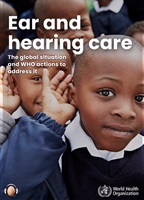

Hearing is the sense with which we perceive the sounds around us; through hearing we engage with our environment, communicate with others, express our thoughts, and gain education. Globally more than 1.5 billion people experience some decline in their hearing capacity during their life course, of whom at least 430 million will require suitable rehabilitation such as the use of hearing devices.
Loss of hearing, if not identified and addressed, can have far-reaching consequences, adversely affecting language development, psychosocial well-being, quality of life, educational attainment and economic independence at various stages of life.The work of WHO’s programme for ear and hearing care is guided by World Health Assembly resolution WHA70.13 (2017) on Prevention of deafness and hearing loss, and the WHO World report on hearing, 2021. The report provides clear evidence to target hearing loss as a global public health priority and outlines the H.E.A.R.I.N.G. package of interventions that countries should prioritize, taking into account their national circumstances.

WHO ear and hearing care resources

It is estimated that while more than 400 million people worldwide could benefit from hearing aid use alone, only 17% get to use these devices. This gap...

The collection of routine data for eye and ear care from health facility reporting underpins health related decision-making in health policy, management...

The Package of interventions for rehabilitation outlines the most essential interventions for rehabilitation for 20 health conditions. For each of the...

This manual is a practical guide on the prevention, identification, and management of hearing loss and common ear diseases that lead to hearing loss. It...

The manual was developed through an evidence-based consultative process. The clinical processes, diagnostic steps and management/referral criteria described...

The Trainer’s handbook accompanies the Primary ear and hearing care training manual. This handbook is intended for use by those involved in...

This document provides a library of messages for use in hearing loss awareness/education/prevention mHealth programmes. These messages have been crafted...

WHO estimates that over one billion young people globally are at risk of hearing loss due to sound exposure in recreational settings. The risk of permanent...